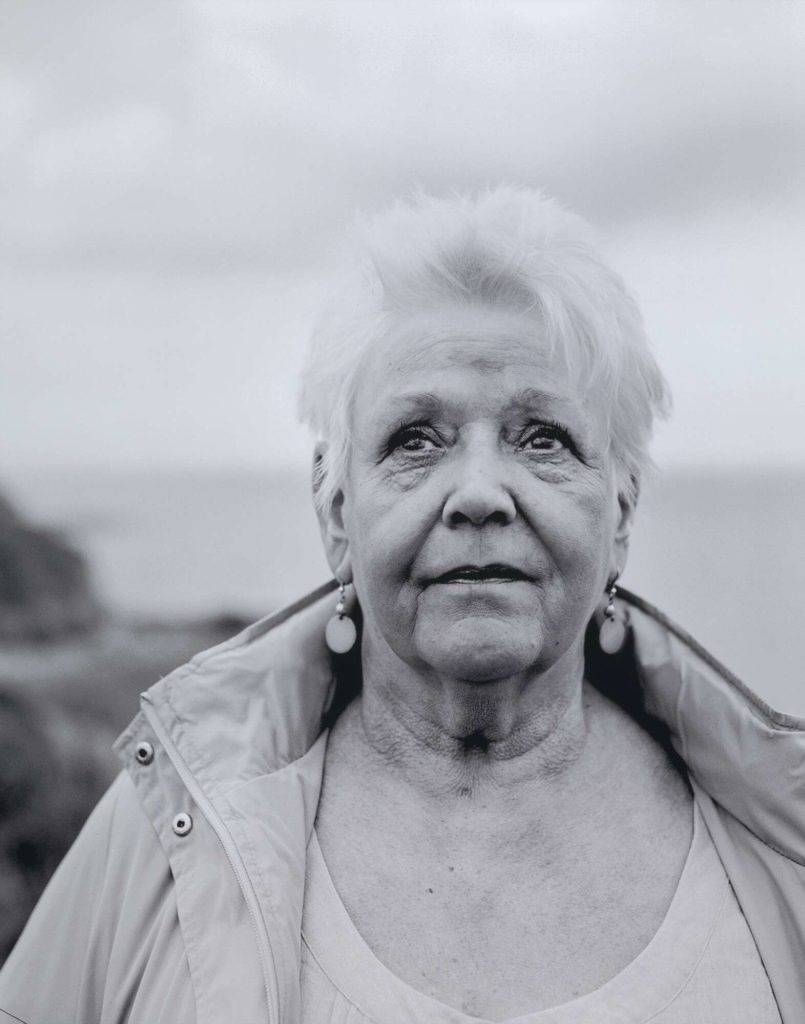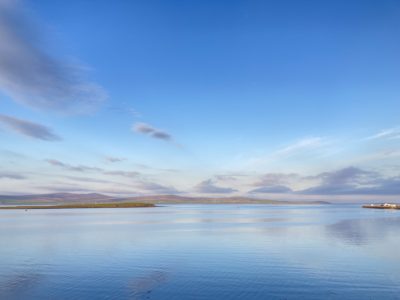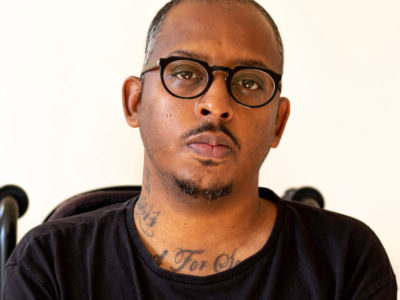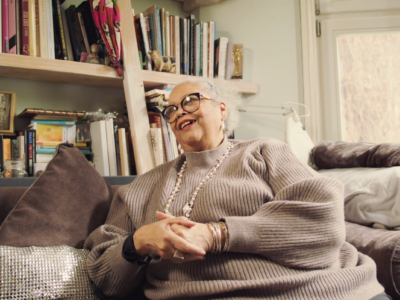Art questions… with Joanne Coates
We sat down with artist Joanne Coates to talk about photography, storytelling and the North East.

Joanne Coates during a visit to the Government Art Collection
// Who is Joanne Coates?
I’m an artist based in the North East of England, in probably one of the most rural places in the UK. My practice revolves around the countryside, rural issues and hidden histories. I mainly use photography, but increasingly I’ve turned to installation, using sound and other elements. I really like to create worlds and think about how I tell stories.
// How did you become an artist?
I didn’t know anyone who was a photographer or an artist growing up. I didn’t know that education was for me, so I didn’t go to university until I was 21. Something I was always obsessed with was stories. I had problems with speech growing up, so stories were always how I interpreted the world. I think photography is my way of making sense of the world. I left the North East at 16 and went to Manchester, and then Leeds, and then London. I first studied fine art, and then photography at London College of Communication. I knew that I wouldn’t be able to stay in London because I was already finding it difficult to afford studying there. So I tried to get the most out of my time there because I knew that I would eventually have to leave.

Joanne Coates, Lynn, Miner’s Wife, Activist, Organiser (Part of the series Lie of the Land), 2022
// How do you find the people and the stories that you want to tell?
Finding the people who will take part can be quite organic. My most recent work is called The Middle of Somewhere (at The Baltic until 17 November 2024) and it focuses on women and the countryside in Orkney and the north eastern Yorkshire Dales. I had already done a piece of work in Orkney and I’d come back every year since. Becky, a woman who I had worked with before, mentioned a young woman called Aisling and said we would connect well. So that’s one way I meet people. Sometimes it’s an open call on local radio, or on social media. But having a simple chat is a great way to meet people.
// The term ‘rural gentrification’ comes up often in your work. Could you talk about that and why you’ve focused on it?
I quite often think about John Clare, the peasant poet and how the enclosures [a series of Acts of Parliament which took common land in the country and restricted their use to their legal owner] affected his way of rural life. When he came to London, it was such a disconnect for him; his sense of identity was so tied with his work in the land, as well as his poetry.
When we think of gentrification, we think of urban gentrification and the urban poor having to leave an area; we don’t think of the rural poor. In the eighties, people left the city en masse, searching for the countryside idyll. But what happened then is the working population had to leave, to balance this out. Tourism is now largely responsible for changing landscapes, rising rents and displacements but it is also how many of the rural population are able to stay and make a living.
Now, there are people in the countryside who don’t have access to dentists or access to healthcare and are often struggling. If you have to get two buses and it takes you half a day to get to the job centre or healthcare, what does that mean for you? Also, institutions that would have once held people together in rural places, like the church, are no longer as relevant maybe as they were.
Rural life has been changing quite a lot, but it also needs to. So there’s that push and pull between those emotions. The countryside has always been a space of the working class but there’s also this pastoral, idyllic vision of the countryside. So you’re seeing people having to leave; rural migration is at an all time high amongst young people. Everything is pulled apart in this way. At the same time, people should also be able to access and move to the countryside.
So I guess within my work, there’s that tension between those two things that I feel in myself. I think that comes from being someone who grew up in that area, but also left that area and did benefit from leaving that area, but then returned.
// Do you look for tension and friction in your work?
I think so, because I think I feel it myself sometimes. I feel it myself in the art world as a working class person who couldn’t go to university at 18, for example. So that friction is reflected in my work.

Joanne Coates, Lynn’s object, Brass (Part of the series Lie of the Land), 2022
// Is there a work of yours that stands out for you?
Lynn’s object, Brass (in the Government Art Collection) means quite a lot to me because as part of that series (Lie of the Land), I asked the women involved to choose objects that define their identity.
Where I come from in North Yorkshire, there are two particular communities – the farming and rural community, and then those shaped by the miners’ strikes and the coalfields. And they don’t necessarily connect, even though they’re near each other, they’re different. So this object for me encapsulates those two different histories. When rural workers could finally vote, they celebrated by doing a community walk with the local brass band. That celebration comes through in this brass object that Lynn picked to define her identity. Brass bands have an entirely different history connected to the mining industry. Lynn is from the area, and self-defines as a working class woman. And as part of that series, it was really important to me that [the people who took part] defined themselves because it’s not my judgement to make. This object, it’s her instrument that she plays, is tied to the history of rural communities through the brass band and the mining history.
// Can you talk about Passage To The Past, Masters Shop, Gang Mines 2022 (Part of the series Lie of the Land)?
So this is the Coast to Coast Path, which is now seen as a tourist trail. People follow it to experience the idyll of the countryside but there’s still that friction there because you walk past disused mining areas. The building [in the centre of the image] was where people would have bought their uniform, their equipment, and that money would have always been owed to the government. That was a way of keeping the workers tied there. And now part of it is owned by one of the wealthiest men in the UK, which I think shows how contested the British landscape is.

Joanne Coates, Passage To The Past, Masters Shop, Gang Mines 2022 (Part of the series Lie of the Land), 2022
// How does it feel representing the North East in the Collection?
It’s pretty amazing to be honest. I think it’s really wonderful to see the North East represented because sometimes it’s not. Despite its history of the Pitmen Painters and of brass bands, these real icons, the North East still isn’t seen as a huge cultural resource. To me, it is one of the most exciting spaces and places in terms of the arts in the UK. Representing that is such an honour. It can feel quite nerve wracking because the North East is so huge, so sometimes I do think, where do I fit within that? Am I representing the issues that people care about? But I think because my work is class-based, there is that connection there.
So yeah, it’s nerve wracking, but a huge honour too. And I think more art collections around the UK should look to the North East.
// Last question, can you tell us a bit about the art landscape of the North East and how you think you fit into that?
I think it’s really exciting and innovative. You have The Baltic who really nourish and create space for North East-based artists, as well as international artists. You have MIMA who are looking at disability and they’ve just opened an exhibition that I’m in at the moment, showing that artists who have disabilities are artists in their own right.
I think the North East is really pushing boundaries in ways that I don’t see in other places, and that might be just because I’m from there. I think its history and heritage are really, really unique. Maybe one of the reasons I didn’t get to study until I was 21 is I didn’t see people from where I was being allowed to make art about where they were from. They are often the subject but still aren’t often the artist. I hope that now people are starting to do that, and are able to do that because I definitely think that there is a lack of working class artists, who can’t afford to live anywhere else and are tied to their communities, represented across UK art collections. I think this is slowly changing and I would love to keep seeing those changes. I hope that being part of this collection is part of that change.
If you are interested in learning more about rural gentrification, Jo has suggested further reading: Rural Poverty Today: Experiences of Social Exclusion in Rural Britain, by Mark Shucksmith, Jayne Glass, Polly Chapman and Jane Atterton and Experiences of Social Exclusion in Rural Britain by Mark Shucksmith, Jayne Glass, Polly Chapman and Jane Atterton.


